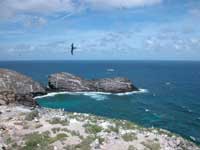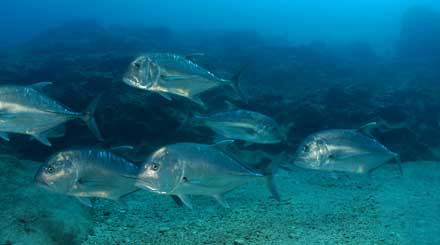NOWRAMP
2002
Mokumanamana(9/10/02)
by
Carlos Eyles
 We
arrive at seven thirty in the morning. The island lies low
on the water, appearing benign and clearly lacking the power
and majesty of Nihoa. Fewer birds greet us as high, thin
clouds with vaporous wings fly across the morning sky, where
the budding sun blazes pale prisms on their feathered tips.
We are one hundred and fifty miles west of Nihoa, three
hundred miles from Kaua‘i. Necker is shaped like a
fish hook and covers 45 acres of land, it is a dry volcanic
island with a surrounding reef area of more than 380,000
acres. The islands is somewhat smaller than Nihoa and it
has no trees, but has plenty of low-lying native plants.
Low to the west a thick bed of clouds struggle to rise from
the horizon only to lose their will to the cerulean sky.
As if two skies were vying for possession of the day.
We
arrive at seven thirty in the morning. The island lies low
on the water, appearing benign and clearly lacking the power
and majesty of Nihoa. Fewer birds greet us as high, thin
clouds with vaporous wings fly across the morning sky, where
the budding sun blazes pale prisms on their feathered tips.
We are one hundred and fifty miles west of Nihoa, three
hundred miles from Kaua‘i. Necker is shaped like a
fish hook and covers 45 acres of land, it is a dry volcanic
island with a surrounding reef area of more than 380,000
acres. The islands is somewhat smaller than Nihoa and it
has no trees, but has plenty of low-lying native plants.
Low to the west a thick bed of clouds struggle to rise from
the horizon only to lose their will to the cerulean sky.
As if two skies were vying for possession of the day.
Short,
low, dung covered cliffs mark the presence of birds, which,
as we near descend from the morning sky to greet us - boobies,
frigates, sooty terns - as we circle the island. The island
appears broken as if two reside within the one, divided
by a small stone isthmus.
I
am eager to get into the water, as is the rest of the documentation
team which includes Jim Watt, still photographer, Mike May,
videographer and Brian Hauk, dive master. We also have John
Elder along, one of the two ship’s doctors. Although
we have made inquires, no one aboard the Rapture seems to
know much about the island in terms of where to find the
best concentration of fish. Which doesn’t surprise
for that, of course is why we are here in the first place,
to discover where to find such populations, or if in fact
one even exists.
 We
are the last boat out today. It is decided to circumnavigate
the island and make jumps into areas that look promising.
In thirty minutes we have come up empty. The windward side,
blowing a solid twenty five knots has a flat and featureless
bottom, seemingly barren of any significant fish population.
We return to the lee side and 250 yards in front of the
anchored Rapture Watt and I make our last jump. Swimming
100 feet off the island we make a free dive to 30 feet and
are greeted by a host of Ulua, (giant trevally) all 35-
55 pounds. We come up and both know instantly the significance
of what we have found.
We
are the last boat out today. It is decided to circumnavigate
the island and make jumps into areas that look promising.
In thirty minutes we have come up empty. The windward side,
blowing a solid twenty five knots has a flat and featureless
bottom, seemingly barren of any significant fish population.
We return to the lee side and 250 yards in front of the
anchored Rapture Watt and I make our last jump. Swimming
100 feet off the island we make a free dive to 30 feet and
are greeted by a host of Ulua, (giant trevally) all 35-
55 pounds. We come up and both know instantly the significance
of what we have found.
While
the rest of the team slips into their scuba gear, I free
dive the Ulua. They appear to have never seen a human and
fearlessly approach. I am on the bottom at 60 feet when
the rest of the school appears. I count 20 fish, several
five feet long, weighing upwards to 100 pounds. They circle
me from three feet away. I am both astonished and awed.
To put this event into some perspective, I have been diving
the Kona Coast of Hawai‘i three times a week for the
last two years, always on the lookout for this most prized
among all fish. I have spotted a grand total of three ulua,
all under fifteen pounds. And now in this little cove I
view for really the first time what all of the Hawaiian
Islands must have held throughout the ages, right up to
the last fifty years. These grand creatures, whose silver
bodies catch all the light in the dark depths and reflect
them back to the viewer, swim in that powerful way relegated
to very large fish. They move without any apparent effort,
guiding along on some other energy that we lesser beings
do not possess. Their large eyes miss nothing, and though
curious appear nonchalant at my presence among them. The
largest, satisfied that I am neither a food source nor a
threat, drift back down the instant I begin to ascend. The
smaller ones follow me up for twenty feet, then turn and
join the others meandering about the bowl shape sandy bottom.
 Two
spotted eagle rays glide by, a green sea turtle halts in
its descent to check me out, a white tip shark weaves its
way through the boulder strewn edge of the island. I confess
to having little interest in anything but these kings of
underwater Camelot; the ulua. I make repeated dives and
the pattern repeats itself. Once they spot me they rise
to investigate, the smaller one first then the giants.
Two
spotted eagle rays glide by, a green sea turtle halts in
its descent to check me out, a white tip shark weaves its
way through the boulder strewn edge of the island. I confess
to having little interest in anything but these kings of
underwater Camelot; the ulua. I make repeated dives and
the pattern repeats itself. Once they spot me they rise
to investigate, the smaller one first then the giants.
I am thoroughly enraptured. Thrilled beyond words.
The
life energy, the soul, if you will, of the natural world
is found in the presence of the very largest of the species
that occupy that domain. They have the countenance of power.
They know who they are, and in what realm they reign, they
have nobility. From first hand experience I have seen the
eradication of such animals and the realm they once occupied
changes dramatically with their absence. Think of a forest
without the grandest of its trees, yes it is still a forest,
but different, its nobility, its soul is no longer in evidence.
It is this very element that so influences humans, it gives
us humility, yet makes us aware of our connection to true
nobility. In reality we are only as noble as the creatures
with which we share space on the planet. To destroy these
awesome creatures most assuredly will be the destruction
of ourselves. Not in the physical sense, but that could
also be true, but in the spiritual sense. Only a healthy
spirit can perceive a healthy environment, and only a healthy
environment can produce a healthy spirit.
 I
swim west down the island as the divers enter the water.
Drop down into the entrance of a large cave 20 feet high
and 15 feet across, from its dark bowels swims a monk seal.
My first sighting of this highly endangered species that
resides only in Hawai‘i . It is wary of me and not
wishing to stress it, I turn away, its large seal eyes following
me as it retreats into the cave. I stop and watch it go,
then it stops and we stare across at each other, unsure,
then both move off. The seal conjures mixed feelings, I
am sad that it is holding on in such a fragile manner and
joy of course, that I was able to witness its lively presence.
I want to know it in the way I know the Ulua, feel its presence,
understand its nobility. Perhaps we will meet again as the
day progresses.
I
swim west down the island as the divers enter the water.
Drop down into the entrance of a large cave 20 feet high
and 15 feet across, from its dark bowels swims a monk seal.
My first sighting of this highly endangered species that
resides only in Hawai‘i . It is wary of me and not
wishing to stress it, I turn away, its large seal eyes following
me as it retreats into the cave. I stop and watch it go,
then it stops and we stare across at each other, unsure,
then both move off. The seal conjures mixed feelings, I
am sad that it is holding on in such a fragile manner and
joy of course, that I was able to witness its lively presence.
I want to know it in the way I know the Ulua, feel its presence,
understand its nobility. Perhaps we will meet again as the
day progresses.
Moving
further west, still close to the island, finding in the
froth of ocean meeting rock, the multitudes; the silver
bait balls that are the primary food source, the bottom
rung of the food chain. I have not seen bait like this for
thirty years when down in the Sea of Cortez, before it was
pillaged to virtually nothing. But here they are and all
I must do is hang with them, and wait. I do not wait for
very long . A school of bluefin trevally blaze by, a hundred
or more. On the Big Island of Hawai‘i, to see just
one on a day’s dive is to have been given a gift, to
see this many is to be blessed. Among them are half a dozen
rainbow runners, followed by several hundred bonito, their
silver bodies cutting quick water. I dive and the entire
entourage turns and comes to me, circling, their phosphorescent
blue of the trevally glowing like shards of neon among the
silver. Dream-like they circle me until I am dizzy. I have
not seen such a sight for thirty years. I believed that
I would never again. I hold the moment for as long as a
breath, then ascend. In those moments my spirit renewed
and filled beyond imagining I watch the fish turn as one
and speed off into the blue to complete the circle of life,
one that shows itself here in startling clarity, like nowhere
else perhaps on the planet.
Heading
back for the boat two monk seals intercept me, twisting
by in either intense play or mating ritual. They ignore
me, and begin to mock bite and in general put on a show
for fifteen seconds then are gone. The circle of life here
comes and goes in a blink of an eye, if you miss it or are
asleep it will still go on, but you will be little less
enriched, perhaps even a little less noble than you might
have been.
<<Journals
Home